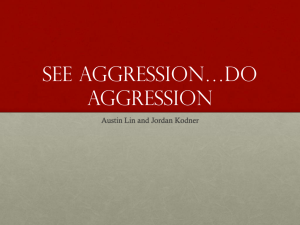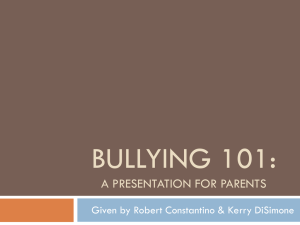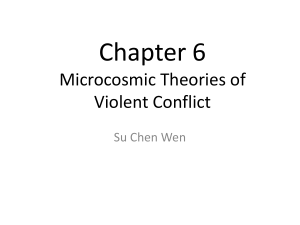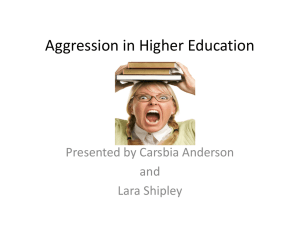Social Psychology
advertisement
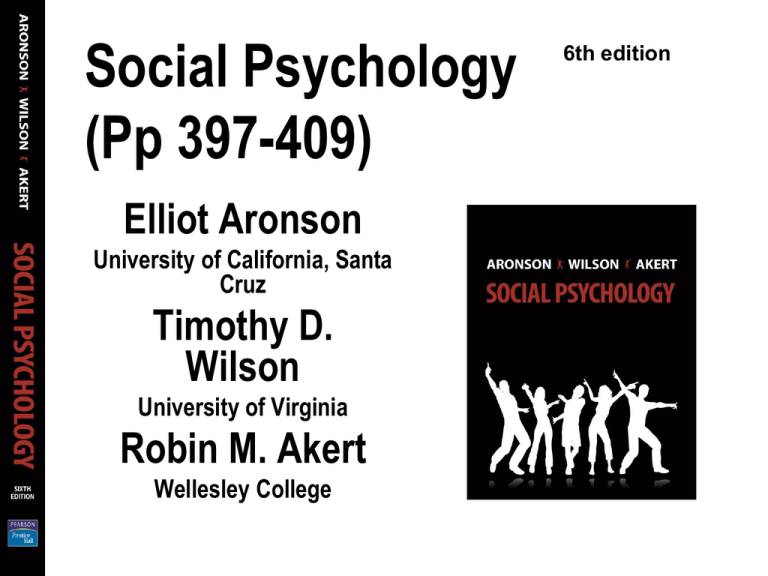
Social Psychology (Pp 397-409) Elliot Aronson University of California, Santa Cruz Timothy D. Wilson University of Virginia Robin M. Akert Wellesley College 6th edition Last Class III. Social Situations and Aggression A. Frustration and Aggression B. Being Provoked and Reciprocating C. Aggressive Objects as Cues D. Imitation and Aggression E. Violence in the Media F. Does Violence Sell? G. Violent Pornography and Violence against Women How to Reduce Aggression “Stop hitting your brother!” “Turn off the TV and go to your room!” • Trying to curb the aggressive behavior of their children, most parents use some form of punishment. • Some deny privileges; others use force. • How well does punishment work? Does Punishing Aggression Reduce Aggressive Behavior? • If punishment takes the form of an aggressive act, the punishers are actually modeling aggressive behavior for the person whose aggressive behavior they are trying to stamp out and might induce that person to imitate their action. • Several experiments demonstrated that threat of relatively severe punishment does not make committing a transgression less appealing to a preschooler. • On the other hand, the threat of mild punishment—of a degree just powerful enough to get the child to stop the undesired activity temporarily—leads the child to try to justify his or her restraint and, as a result, can make the behavior less appealing. Using Punishment on Violent Adults • Does the threat of harsh punishments for violent crimes make such crimes less likely? • Do people who are about to commit violent crimes say to themselves, “I’d better not do this because if i get caught, I’m going to jail for a long time; I might even be executed.” • The scientific evidence is mixed. Source of image: Microsoft Office Online. Using Punishment on Violent Adults Laboratory experiments indicate that punishment can indeed act as a deterrent if two “ideal conditions” are met: • It must be prompt. • It must be unavoidable. In the real world, these ideal conditions are almost never met, especially in a complex society with a high crime rate and a slow criminal justice system like our own. During the past thirty years, the homicide rate in the United States has fluctuated between 6 and 10 murders per year for every 100,000 people in the population. This statistic is striking when one compares it to other industrialized countries like Germany, England, and France, where the homicide rate has remained stable at less than 1 per 100,000. Catharsis and Aggression • Conventional wisdom suggests that one way to reduce feelings of aggression is to do something aggressive. • “Get it out of your system” has been a common piece of advice. • This common belief is based on an oversimplification of the psychoanalytic notion of catharsis. Catharsis and Aggression Catharsis The notion that “blowing off steam”—by performing an aggressive act, watching others engage in aggressive behaviors, or engaging in a fantasy of aggression— relieves built-up aggressive energies and hence reduces the likelihood of further aggressive behavior. The Effects of Aggressive Acts on Subsequent Aggression • When frustrated or angry, many of us do feel less tense after blowing off steam by yelling, cursing, or perhaps even hitting someone. • But does aggression reduce the need for further aggression? Does playing competitive games, for example, serve as a harmless outlet for aggressive energies? • Generally, the answer is no. In fact, the reverse is true: competitive games often make participants and observers more aggressive. The Effects of Aggressive Acts on Subsequent Aggression What about watching aggressive games? Will that reduce aggressive behavior? • As with participating in an aggressive sport, watching one also increases aggressive behavior. The Effects of Aggressive Acts on Subsequent Aggression Finally, does direct aggression against the source of your anger reduce further aggression? Again, the answer is no. • When people commit acts of aggression, such acts increase the tendency toward future aggression. • Outside the lab, in the real world, we see the same phenomenon: Verbal acts of aggression are followed by further attacks. Blaming the Victim of Our Aggression • When somebody angers us, venting our hostility against that person does seem to relieve tension and make us feel better, at least temporarily—assuming the person we vent on doesn’t decide to vent back on us. • But “feeling better” should not be confused with a reduction in hostility. • With human beings, aggression is dependent not merely on tensions—what a person feels— but also on what a person thinks. Blaming the Victim of Our Aggression • Research participants who inflicted either psychological or physical harm on an innocent person who had done them no prior harm then derogated their victims, convincing themselves they were not nice people and therefore deserved what they got. • This reduces dissonance, all right—and it also sets the stage for further aggression, for once a person has succeeded in derogating someone, it makes it easier to do further harm to the victim in the future. What Are We Supposed to Do with Our Anger? It is possible to control our anger by actively enabling it to dissipate. “Actively enabling” means using such simple devices as counting to ten before shooting your mouth off. Source of image: Microsoft Office Online. Venting versus Self-Awareness • If your close friend or spouse does something that makes you angry, you may want to express that anger in a way that helps you gain insight into yourself and the dynamics of the relationship. • But for that to happen, the anger must be expressed in a nonviolent and non-demeaning way. Venting versus Self-Awareness • Although it is probably best to reveal your anger to the friend who provoked it, at least if you are hoping to resolve the problem between you, sometimes it is helpful to write down your feelings in a journal. • Benefits of “opening up” are due not simply to venting of feeling but primarily to the insights and self-awareness that usually accompany such self-disclosure (Pennebaker, 1990). Defusing Anger through Apology • One way to reduce aggression is for the individual who caused the frustration to take responsibility for the action, apologize for it, and indicate that it is unlikely to happen again. “Oops! My bad!” The Modeling of Nonaggressive Behavior • Modeling works with nonaggressive behavior too. • When children see adults, when provoked, express themselves in calm, respectful manner, children subsequently handle their own frustrations with less aggression. Source of image: Microsoft Office Online. Training in Communication and Problem-Solving Skills • Feeling angry is part of being human • The problem is the expression of anger in violent or cruel ways • Formal training programs can be an effective means for reducing aggression Training in Communication and Problem-Solving Skills Formal Training Techniques: Communicating anger or criticism in constructive ways Negotiating and compromising when conflicts occur Being more sensitive to the needs and desires of others Building Empathy • It is difficult to inflict pain on a stranger without dehumanizing the victim • Building empathy among people (putting oneself in the shoes of another person and vicariously experiencing some of the same feelings that person is feeling) makes aggressive acts more difficult to commit The Southern Poverty Law Center: How to Reduce Bullying The Southern Poverty Law Center is a nonprofit civil rights organization dedicated to fighting hate and bigotry, and to seeking justice for the most vulnerable members of society. Step One Know about the issue and believe it is a problem (Bully DVD) What is Bullying? In your own words, how would you define bullying? Indiana Law (HEA 1423) Overt (intentional), unwanted, repeated acts or gestures including: Verbal or written communication or images transmitted in any manner (including digitally or electronically) Physical acts committed by a student or group of students against another student with the intent to Harass, ridicule, humiliate, intimidate or harm the targeted student and Create for the targeted student an objectively hostile school environment Types of Bullying Physical Verbal Social/Relational Electronic or Written Communication Physical Bullying Hitting/kicking/pinching Spitting Tripping/pushing Taking or breaking someone’s things Making mean or rude hand gestures Verbal Bullying Teasing Name-calling Inappropriate sexual comments Taunting Threatening to cause harm Social/Relational Bullying Leaving someone out on purpose Telling others not to be friends with someone Spreading rumors about someone Embarrassing someone in public Electronic (Cyber) Bullying Mean text messages or emails Rumors and/or embarrassing pictures/videos sent by email or posted on social networking sites Creating fake profiles Bullying By The Numbers 160,000… Estimated number of U.S. students who skip school daily to avoid being bullied 32%... Students who report being bullied at school during the school year 86%... Gay or lesbian students who report being bullied Bullying By The Numbers 70%... Teachers surveyed who say that educators “almost always” intervene when bullying occurs 35%... 9th graders who believe their teachers are interested in trying to stop bullying 66%... Bullying victims who believe school professionals responded poorly to the bullying they observed Facts and Myths About Bullies TRUE OR FALSE? Nearly one-third of American teens are involved in bullying. Fewer than 10% of American teens admit to bullying others. Most students who bully are insecure. Male bullies are not usually bigger or physically stronger than their peers. Bullies have trouble making friends. Bullies do poorly in school compared to students who do not bully. Most bullies discontinue aggressive behavior in adulthood. Step Two Identify the needs of your school or community Step Three Develop an Action Plan Norway Study (P. 398) Psychologist Dan Olweus (1991) curbed bullying in Norway by: 1) 2) 3) 4) Surveying all 90,000 schoolchildren Using the data (that bullying was serious and widespread), communitywide meetings were held to explain the problem Classes discussed ways to prevent bullying Counselors intervened using a combination of mild punishments and intensive therapy with the bully and counseling with his/her parents Resources Find Youth Info bullyinginfo .org Safe Schools Coalition safeschoolscoalition.org Committees for Children cfchildren.org Resources Gay, Lesbian and Straight Education Network glsen.org The Bully Project thebullyproject.com The End


